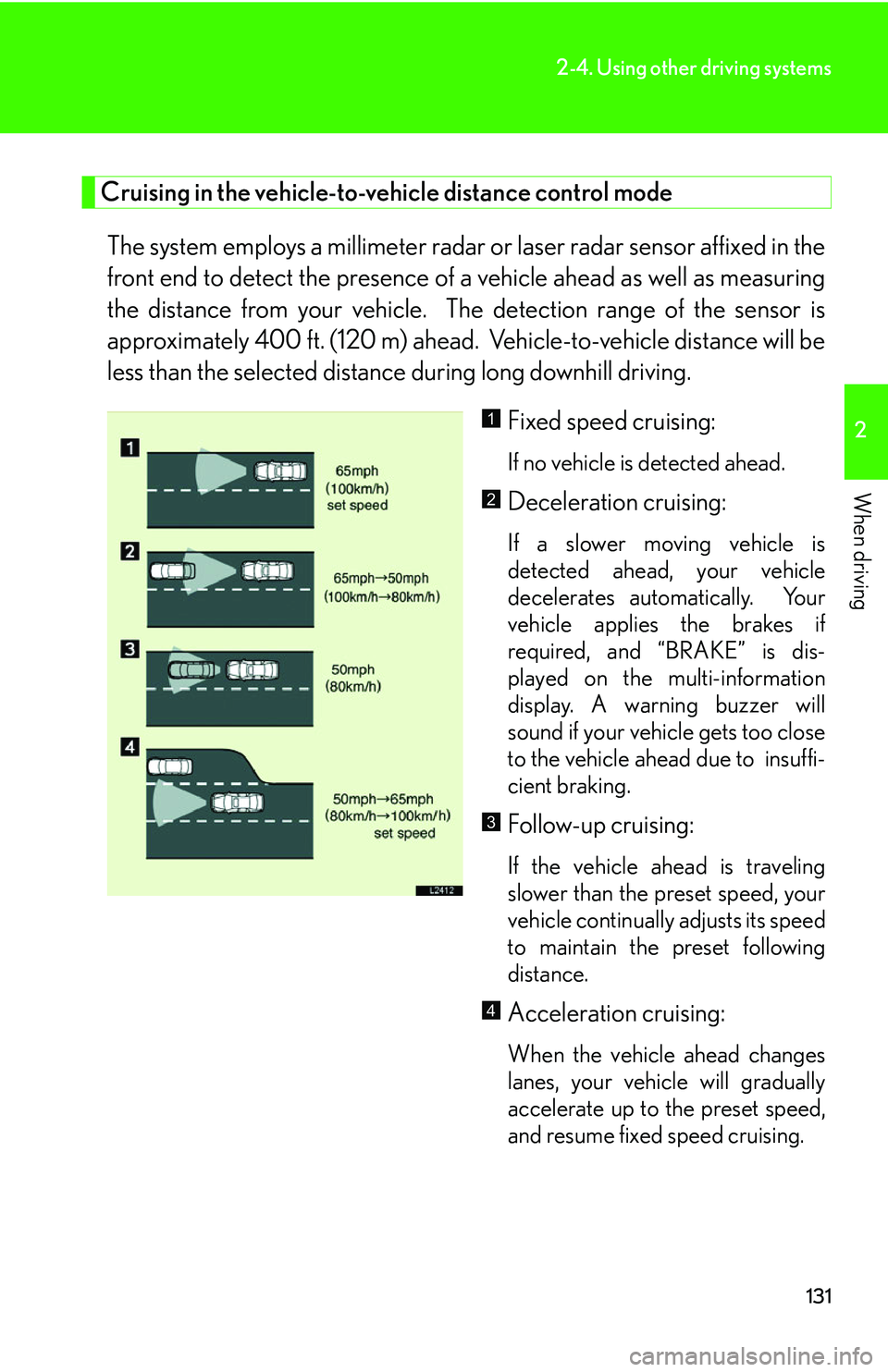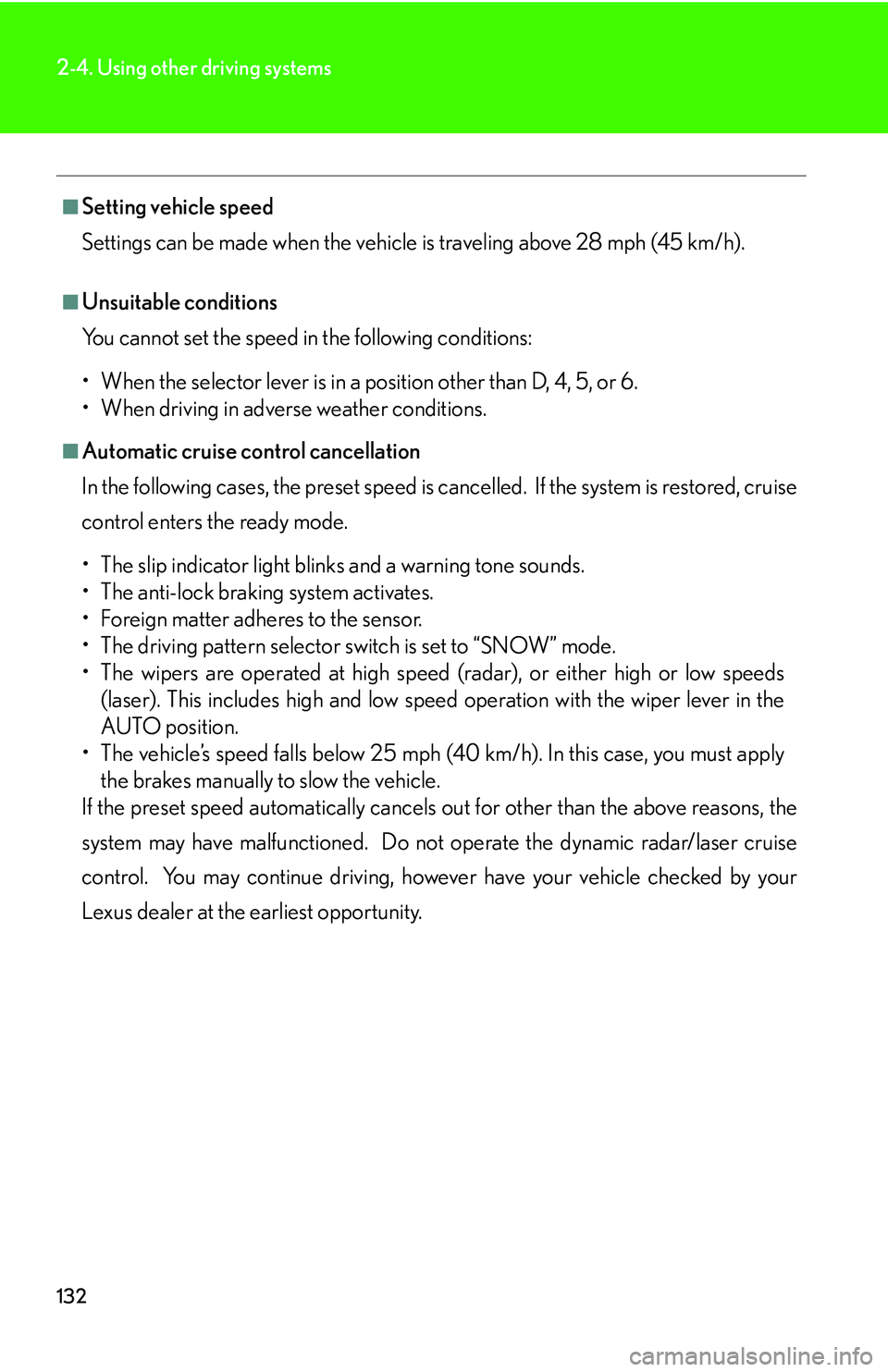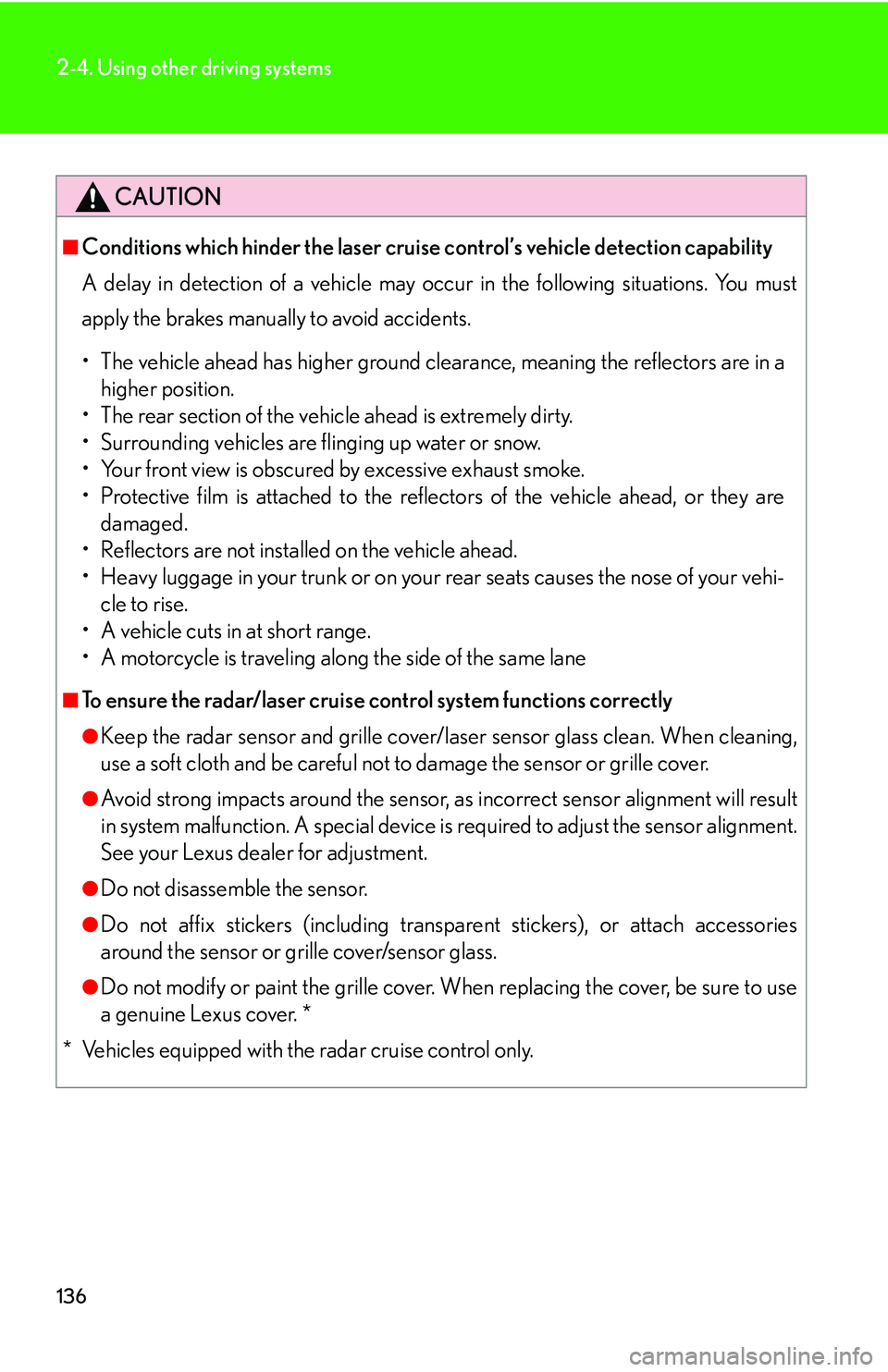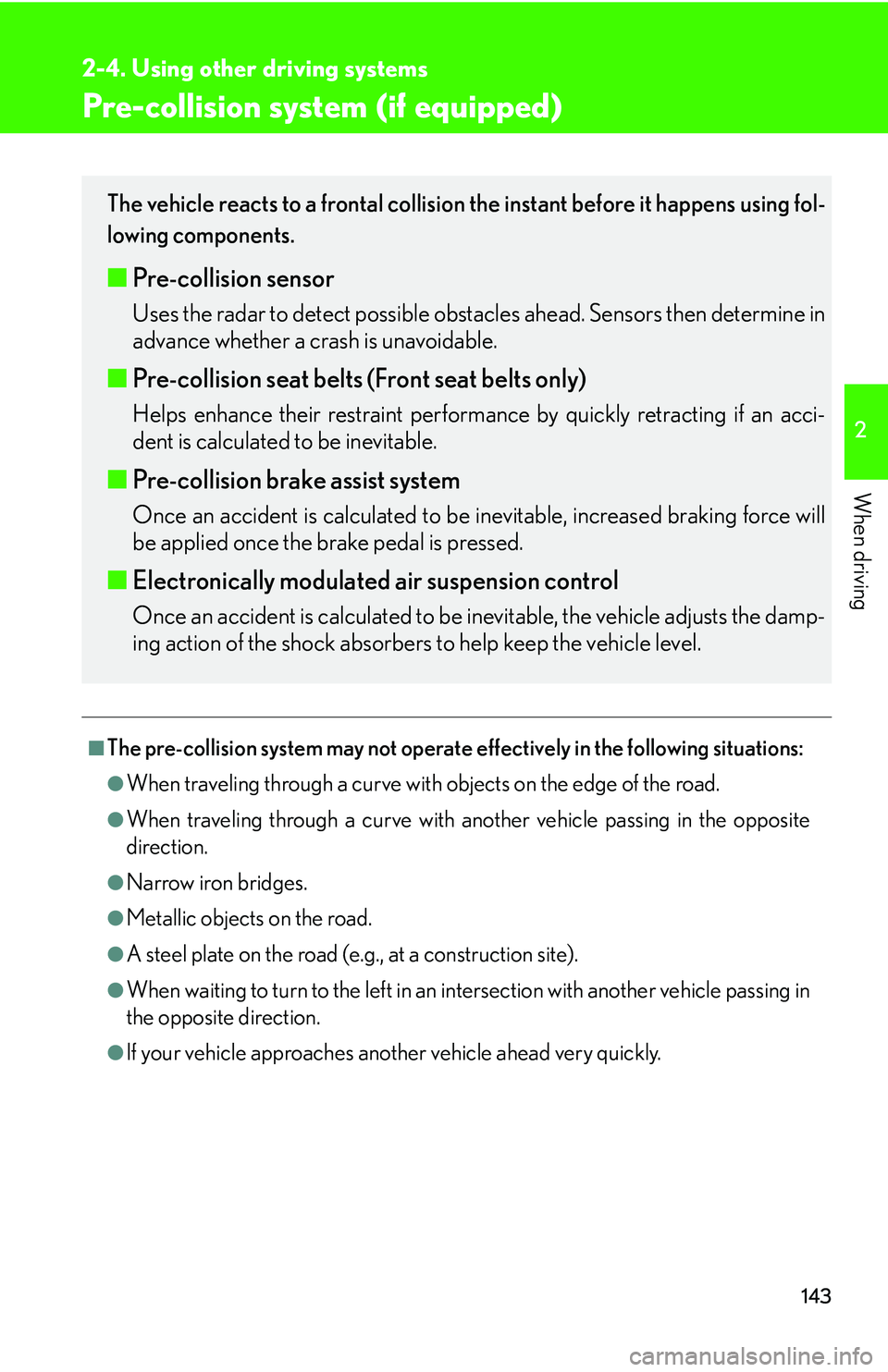Page 138 of 419
122
2-4. Using other driving systems
CAUTION
■To prevent park assist system malfunction
Do not install anything within the sensor detect
ion range (accessories, etc.). Doing
so could cause a malfunction, which could lead to an accident.
NOTICE
■Situations which may cause detection failure
●Sensors will not detect obstacles directly under the bumper. A short object, thin
stake or the like may cease to be detected as the vehicle draws close.
●If an obstacle is very close to the vehicle.
●Sensors will malfunction if subjected to a strong impact.
■System malfunction
●An accident will affect the sensors, resulting in system failure.
●If the indicators remain on without a beeping sound, the system may be malfunc -
tioning. Contact your Lexus dealer.
Page 147 of 419

131
2-4. Using other driving systems
2
When driving
Cruising in the vehicle-to-vehicle distance control mode
The system employs a millimeter radar or laser radar sensor affixed in the
front end to detect the pr esence of a vehicle ahead as well as measuring
the distance from your vehicle. The detection range of the sensor is
approximately 400 ft. (120 m) ahead. Vehicle-to-vehicle distance will be
less than the selected distance during long downhill driving.
Fixed speed cruising:
If no vehicle is detected ahead.
Deceleration cruising:
If a slower moving vehicle is
detected ahead, your vehicle
decelerates automatically. Your
vehicle applies the brakes if
required, and “BRAKE” is dis -
played on the multi-information
displa
y. A warning buzzer will
sound if your vehicle gets too close
to the vehicle ahead due to insuffi -
cient braking.
Follow-up cruising:
If the vehicle ahead is traveling
slower than the preset speed, your
vehicle continually adjusts its speed
to maintain the preset following
distance.
Acceleration cruising:
When the vehicle ahead changes
lanes, your vehicle will gradually
accelerate up to the preset speed,
and resume fixed speed cruising.
1
2
3
4
Page 148 of 419

132
2-4. Using other driving systems
■Setting vehicle speed
Settings can be made when the vehicle
is traveling above 28 mph (45 km/h).
■Unsuitable conditions
You cannot set the speed in the following conditions:
• When the selector lever is in a position other than D, 4, 5, or 6.
• When driving in adverse weather conditions.
■Automatic cruise control cancellation
In the following cases, the preset speed is can ce
lled. If the system is restored, cruise
control enters the ready mode.
• The slip indicator light blinks and a warning tone sounds.
• The anti-lock braking system activates.
• Foreign matter adheres to the sensor.
• The driving pattern selector sw it
ch is set to “SNOW” mode.
• The wipers are operated at high speed (radar), or either high or low speeds (l
aser). This includes high and low speed operation with the wiper lever in the
AUTO position.
• The vehicle’s speed falls below 25 mph (40 km/h). In this case, you must apply th
e brakes manually to slow the vehicle.
If the preset speed automatically cancels out for other than the above reasons, the
sy
stem may have malfunctioned. Do not operate the dynamic radar/laser cruise
control. You may continue driving, howe ver have your vehicle checked by your
Lexus dealer at the earliest opportunity.
Page 149 of 419

133
2-4. Using other driving systems
2
When driving
■Vehicle-to-vehicle distances
Select a vehicle-to-vehicle distance appropriate
to traffic conditions. The approxi-
mate vehicle-to-vehicle distance based on time interval when driving at 55 mph
(88 km/h) is sho
wn below:
If the vehicle speed is slower than 55 mph (88 km/h), the distance will be shorter
than ab
ove.
■Millimeter wave radar lase r sensor/ Laser radar sensor
The radar or laser sensor automatically detects dirt on the sensor or grill cover
(r
adar cruise control), or the sensor glass (laser cruise control). If dirt is detected, a
message is displayed on the multi-informatio n display, and the radar or laser cruise
control function is automatically cancelled.
ModeVehicle-to-vehicle distance
Long245 f t. (approx. 75 m)
Middle164 ft. (approx. 50 m)
Short100 ft. (approx. 30 m)
Vehicles with dynamic radar cruise con-
trol
(Standard for vehicles with the Pre-Col-
lision system)
Grill cover
Sensor
Vehicles with dynamic laser cruise con-
trol
Sensor
Page 150 of 419

134
2-4. Using other driving systems
■Certifications for the millimeter wave radar laser sensor/ laser radar sensor
(U.S.A.)
●Millimeter wave radar sensor
FCC WARNING:
Changes or modifications not expressly approved by the party responsible for
com
pliance could void the user’s authority to operate the equipment.
FCC RF exposure information:
This device complies with the FCC RF exposure requirements.
●Laser radar sensor
This product is a class I laser product complied with 21 C.F.R part 1040.10 and
10
40.11.
■Certifications for the millimeter wave radar laser sensor/ laser radar sensor
(Canada)
Millimeter wave radar sensor
Operation is subject to the following two conditions;
1. this device may not c
ause interference, and
2. this device must accept any interference r
eceived, including interference that
may cause undesired operation of the device.
■If the master warning light comes on and a warning message appears on the
multi-information display
If a system malfunction occurs when the dyn
amic radar/laser cruise control is on or
in the “RADAR READY” mode, the master warning light comes on, the “CRUISE”
indicator light flashes, a warning tone so unds, and “Check Cruise System” is dis-
played. ( P.334 )
Page 152 of 419

136
2-4. Using other driving systems
CAUTION
■Conditions which hinder the laser cruise control’s vehicle detection capability
A delay in detection of a vehicle may occur in the following situations. You must
ap
ply the brakes manually to avoid accidents.
• The vehicle ahead has higher ground clearance, meaning the reflectors are in a higher position
.
• The rear section of the vehicle ahead is extremely dirty.
• Surrounding vehicles are fl in
ging up water or snow.
• Your front view is obscured by excessive exhaust smoke.
• Protective film is attached to the reflectors of the vehicle ahead, or they are d
amaged.
• Reflectors are not installed on the vehicle ahead.
• Heavy luggage in your trunk or on your r
ear seats causes the nose of your vehi-
cle to rise.
• A vehicle cuts in at short range.
• A motorcycle is traveling along the side of the same lane
■To ensure the radar/laser cruise control system functions correctly
●Keep the radar sensor and grille cover/la ser sensor glass clean. When cleaning,
use a soft cloth and be careful not to damage the sensor or grille cover.
●Avoid strong impacts around the sensor, as incorrect sensor alignment will result
in system malfunction. A special device is required to adjust the sensor alignment.
See your Lexus dealer for adjustment.
●Do not disassemble the sensor.
●Do not affix stickers (including transparent stickers), or attach accessories
around the sensor or grille cover/sensor glass.
●Do not modify or paint the grille cover. When replacing the cover, be sure to use
a genuine Lexus cover. *
* Vehicles equipped with the radar cruise control only.
Page 159 of 419

143
2-4. Using other driving systems
2
When driving
Pre-collision system (if equipped)
■The pre-collision system may not operate effectively in the following situations:
●When traveling through a curve with objects on the edge of the road.
●When traveling through a curve with another vehicle passing in the opposite
direction.
●Narrow iron bridges.
●Metallic objects on the road.
●A steel plate on the road (e.g., at a construction site).
●When waiting to turn to the left in an in tersection with another vehicle passing in
the opposite direction.
●If your vehicle approaches another vehicle ahead very quickly.
The vehicle reacts to a frontal collision the instant before it happens using fol-
lowing components.
■ Pre-collision sensor
Uses the radar to detect possible obst acles ahead. Sensors then determine in
advance whether a crash is unavoidable.
■ Pre-collision seat belts (Front seat belts only)
Helps enhance their restraint performance by quickly retracting if an acci -
dent is calculated to be inevitable.
■ Pre-collision brake assist system
Once an accident is calculated to be inevitable, increased braking force will
be applied once the brake pedal is pressed.
■ Electronically modulated air suspension control
Once an accident is calculated to be inevitable, the vehicle adjusts the damp -
ing action of the shock absorbers to help keep the vehicle level.
Page 160 of 419
144
2-4. Using other driving systems
CAUTION
■Pre-collision system limitations
●The Pre-Collision System is designed to help reduce the crash speed and dam-
age in certain frontal collisions only. It is not a collision avoidance system and is
no
t a substitute for safe and attentive driving. System effectiveness depends on
many factors, such as speed, dr iver input and road conditions.
●The sensor is able to detect objects in front of the vehicle within 10 degrees on
either side. If the object is out of range, or there is little to no millimeter wave
reflection, the sensor will not detect the object.
●Even if the system is operative in a collisio n, unless the seat belts are worn and the
brake pedal is depressed, the pre-collision seat belts and brake assist system will
operate.
■Failure Warning
If an error is detected, the master warn i
ng light comes on, a warning tone sounds
and the following warning message appears on the multi-information display.
( P.334 )